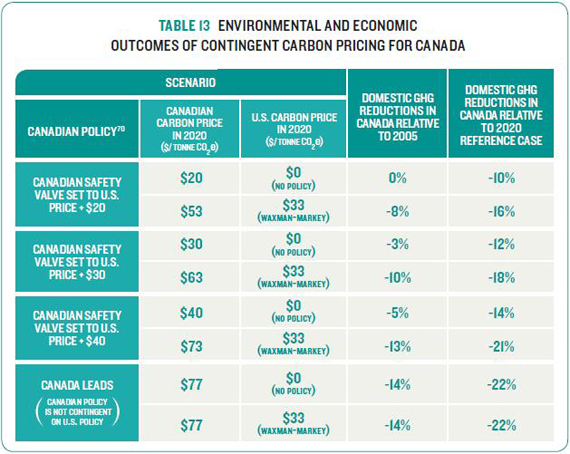Parallel Paths – 4.4 Contingent Carbon Pricing to Limit Competitiveness Risks and Achieve Emission Reductions
Contingent carbon pricing would limit both environmental and economic risks.
Making the Canadian carbon price contingent on the U.S. price could allow Canada to sit somewhere between harmonizing on price and targets, managing the risks of potentially high carbon prices and achieving emission reductions. Specifically, Canadian cost containment design mechanisms could be used to allow a moderate, but limited difference between the Canadian and U.S. carbon price. Under this approach, the Canadian carbon price would be contingent on the U.S. carbon price, without matching it identically. By allowing a moderate price differential, Canada could implement policy immediately even if the U.S. continues to lag. Once the U.S. implements policy, the maximum Canadian carbon price would then float to a specified amount above the U.S. market price, limiting competitiveness impacts. If Canadian costs of abatement are less than expected, the safety valve might not be utilized, and Canadian prices would stay even lower. This approach would drive greater abatement than if the Canadian carbon price was fixed exactly to the U.S. price and it would begin to reduce emissions sooner.
In the scenarios presented in Table 13, Canadian policy includes a safety valve that is set to float above the U.S. market price, thus limiting the carbon price differential. We explore price differentials to assess implications of leading more aggressively or conservatively. We test this approach by modelling scenarios in which the U.S. implements no policy at all, and in which it implements a policy similar to the Waxman-Markey proposal, which relies extensively on offsets to maintain a low U.S. carbon price.

Setting a higher allowable price differential to that of the U.S. would allow Canada to achieve greater reductions. In all the contingent pricing scenarios in Table 13, the Canadian price is insufficient to drive enough domestic abatement to meet Canada’s target, though with international permits the +$40 / tonne scenario comes close. Importantly, however, Canada achieves some reductions by 2020 no matter what action the U.S. takes. Of even greater importance, a contingent pricing approach establishes long-term policy certainty, which is essential for providing an incentive to firms to invest in low-carbon technology.
Contingent pricing is thus an opportunity for Canada to lead responsibly and manage economic risks, whether the U.S. acts or not. A greater price differential results in higher Canadian carbon prices and slightly reduced economic growth, though since all the contingent policies have smaller carbon prices than the Canada Leads scenario, overall economic impacts are small. We will highlight economic outcomes of these contingent policies combined with alternative revenue recycling approaches in Chapter 5.
[70] In these runs, in addition to the domestic abatement shown, additional Canadian compliance is achieved through international permit purchases, and the remainder through technology fund permit purchases. As a result, Canada does not achieve its targets in the contingent policy run, although it does achieve the 2020 target in the Canada Leads run shown at the bottom of the table for context . We will return to these scenarios in Chapter 5 when we propose a Transitional Policy Option for Canada.
























